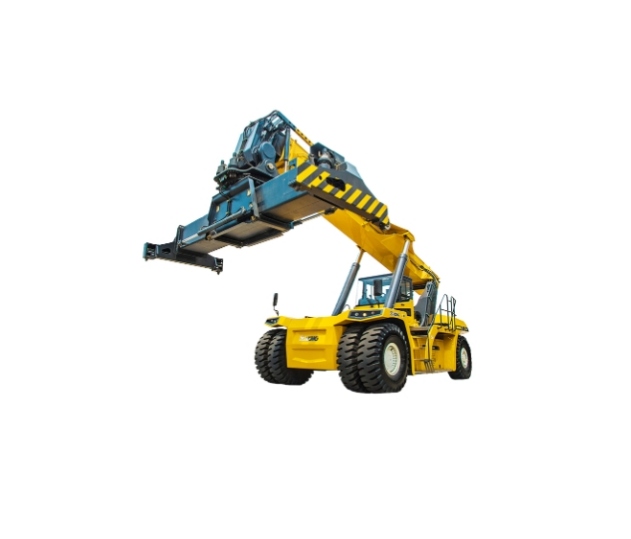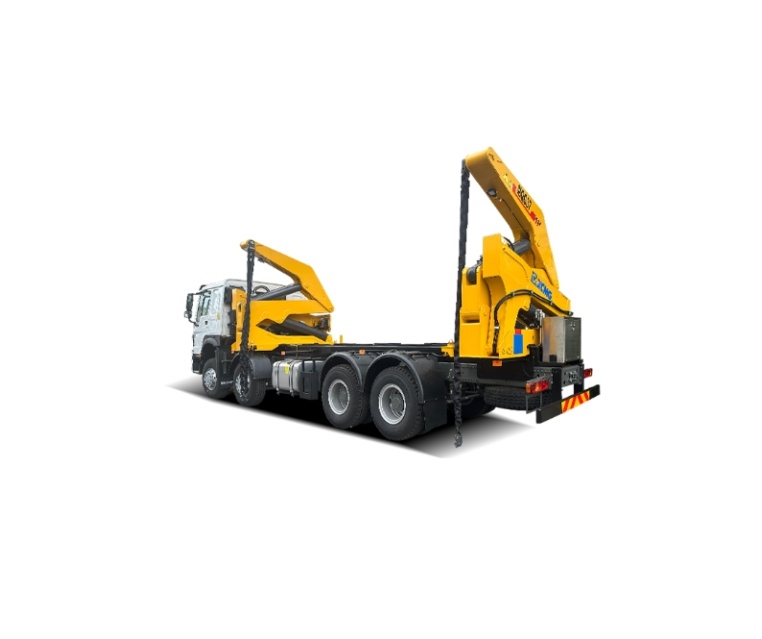Reach stackers and side stackers are two different types of container or cargo lifting equipment, and their main differences are reflected in structural design, operation methods and application scenarios.
Les chargeurs frontaux et les chargeurs latéraux sont deux types différents d’équipements de levage de conteneurs ou de marchandises. Les principales différences se reflètent dans la conception structurelle, les méthodes d’exploitation et les scénarios d’application.
The following are their core differences:
1. Definition and structure/Définition et structure
Reach stacker/Reach stacker
Structure: Usually a tire-mounted mobile device with the cab located in the middle or rear of the device and equipped with a retractable spreader (such as a container spreader).
Features: Loading and unloading operations are carried out from the front of the equipment, and the spreader needs to be moved to the top of the container for operation.
Common types: reach stacker, forklift, etc.
Side hanging/Suspension latérale
Structure: The equipment is designed for lateral operation, with the spreader located on the side of the equipment and usually capable of lateral movement.
Features: No need to fully align the container or cargo, loading and unloading can be done directly from the side, suitable for narrow or long sites.
Common types: rail-mounted side cranes, container side cranes (such as special equipment for railway freight yards).
2. Operation method/Méthode de fonctionnement
Reach stacker/Reach stacker
During operation, the equipment needs to be moved to the front of the container, and the spreader grabs the cargo vertically from above.
It requires a larger operating space and has higher flexibility, making it suitable for multi-layer stacking of containers in the yard.
Side hanging/Suspension latérale
Grab or place goods directly from the side of the equipment without having to frequently adjust the position of the equipment.
It is suitable for scenarios where multiple rows of containers are placed side by side (such as railway flatbed trucks), and has higher operating efficiency.
3. Application scenarios
Reach stacker/Reach stacker
Typical scenarios: port yards, logistics parks, and container transshipment stations.
Advantages: Strong adaptability, can stack, transport, load and unload containers, suitable for complex working environments.
Side hanging/Suspension latérale
Typical scenarios: railway freight yards, narrow warehouses, and long working areas.
Advantages: Space-saving, suitable for fast loading and unloading of multiple rows of goods (such as containers on railway flatbeds).
4. Comparison of advantages and disadvantages
Comparaison des avantages et des inconvénients
1) Flexibility:
Reach stacker: can move in multiple directions, high flexibility
Side hanging: requires fixed working direction, low flexibility
2) Space requirements
Reach stacker: requires front operating space, so large space requirement
Side hanging: suitable for narrow places, so less space required
3) Operation efficiency
Front loaders: Frequent position adjustment is required, so the operating efficiency is average
Side lifting: Direct side operation, high working efficiency
4) Applicable cargo types
Reach stacker: suitable for containers and large cargo
Side load: suitable for containers and long goods (such as railway transportation)
5. Popular understanding/Compréhension populaire
The reach stacker is similar to a “forklift operation” and needs to be operated towards the front of the goods, which is suitable for open areas.
Side lifting is similar to “lateral operation of gantry crane” and is suitable for scenarios with limited space, such as railway freight yards.
Le reach stacker est similaire à une « opération de chariot élévateur » et doit être utilisé vers l’avant des marchandises, ce qui convient aux zones ouvertes.
Le levage latéral est similaire au « fonctionnement latéral d’une grue à portique » et convient aux scénarios avec un espace limité, tels que les gares de marchandises ferroviaires.
Summarize/Résumer
Choose a reach stacker: when the site is open and flexible handling and multi-layer stacking are required (such as ports).
Choose side loaders: when space is limited and multiple rows of goods need to be handled efficiently (such as rail transport or lateral loading and unloading in warehouses).
Choisissez un reach stacker : lorsque le site est ouvert et qu’une manutention flexible et un empilage multicouche sont nécessaires (comme les ports).
Choisissez des chargeurs latéraux : lorsque l’espace est limité et que plusieurs rangées de marchandises doivent être manipulées efficacement (comme le transport ferroviaire ou le chargement et le déchargement latéraux dans les entrepôts).
Selecting equipment according to specific needs can significantly improve work efficiency and reduce costs.
La sélection d’équipements en fonction de besoins spécifiques peut améliorer considérablement l’efficacité du travail et réduire les coûts.
How to buy Container reach stacker maintenance related accessories at CCMIE?
If you need to buy Container reach stacker/Gerbeur à conteneurs , you can contact us. If you need to buy a second-hand Container reach stacker , you can also contact us. CCMIE provides you with comprehensive Container reach stacker.
Post time: May-18-2025


